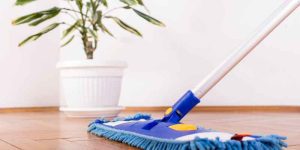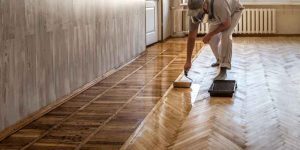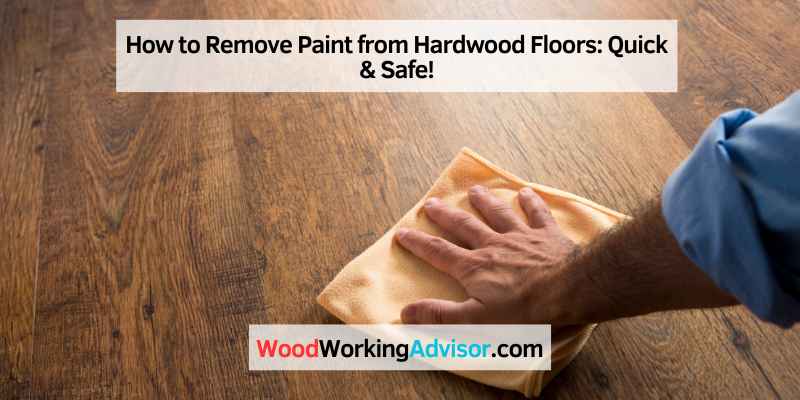To remove paint from hardwood floors, use a plastic scraper and a damp cloth. Avoid harsh chemicals to protect the wood.
Removing paint from hardwood floors can be a daunting task, but it’s essential for maintaining the beauty of your home. Hardwood floors add warmth and elegance to any space, and preserving their natural finish is crucial. Using the right tools and techniques can make the process easier and prevent damage.
Start with a plastic scraper to gently lift the paint without scratching the surface. Follow up with a damp cloth to wipe away any residue. For stubborn spots, a mild soap solution can help. Patience and care are key to restoring your hardwood floors to their original luster.
Introduction To Paint Removal From Hardwood Floors
Removing paint from hardwood floors is hard. Old paint can be stubborn. Some paints are oil-based. Oil-based paints are tough to remove. Floors can get scratched easily. Scratches ruin the floor’s beauty. Chemicals can damage the wood. Strong chemicals are risky. Some methods need special tools. Not everyone has these tools. Floors can have grooves. Paint sticks in grooves. Cleaning grooves is tricky. Water can harm wood. Wet wood can warp. Dry wood is best. Patience is needed. Rushing can cause mistakes.
Safe methods protect your floor. Safe methods also protect your health. Harsh chemicals can be dangerous. Some chemicals cause breathing problems. Children and pets are at risk. Eco-friendly solutions are better. They are safer for everyone. Gentle tools are good for wood. Soft brushes can clean well. Test a small area first. This checks for reactions. Follow all safety rules. Wear gloves and a mask. Keep the room ventilated. Clean up properly. Dispose of chemicals safely. Protect your floors and health.

Types Of Paint Spills
Different types of paint spills, such as latex, oil-based, and acrylic, require specific removal methods from hardwood floors. Removing paint effectively involves understanding the type of paint and using the right tools and techniques.
Water-based Vs. Oil-based
Water-based paint is easy to clean. Use soap and water. Oil-based paint needs a stronger cleaner. Use mineral spirits. Water-based paint dries faster. Oil-based paint takes longer to dry. Check the paint type before cleaning.
Fresh Vs. Dried Paint
Fresh paint is easier to remove. Wipe it with a wet cloth. Dried paint needs more work. Use a scraper or paint remover. Be gentle with hardwood floors. Test a small area first. This keeps your floor safe.
Preparation Steps
Gather necessary tools such as a putty knife, paint remover, and cleaning supplies. Ensure the area is well-ventilated and protected with drop cloths.
Assessing The Damage
Check the paint spots on the floor. Determine if the paint is water-based or oil-based. Look for any scratches or marks. Make sure the floor is not damaged. Find out the size of the paint spill. Note the type of wood. This will help in choosing the right method. Test a small area first.
Gathering Necessary Supplies
Collect a plastic scraper and soft cloth. Get a bucket of warm water. Buy a mild detergent. Have a sponge ready. You might need some rubbing alcohol. Keep a gentle scrub brush handy. Gather all supplies before starting. This saves time and effort.
Methods For Fresh Paint Spills
Remove paint from hardwood floors by using a plastic scraper and gentle solvents. Clean the area with a damp cloth to finish.
Blotting Technique
Use a clean cloth to blot the paint spill. Do not rub the paint. Rubbing can spread the paint. Blot gently to soak up the paint. Repeat with a new cloth if needed. This helps remove the paint quickly.
Mild Soap Solution
Mix a few drops of mild soap with water. Dip a cloth in the solution. Wipe the paint spot gently. Rinse the cloth and wipe again. This can help clean the paint. Dry the area with a clean cloth.
Techniques For Dried Paint Removal
Use a plastic scraper to remove dried paint. Metal scrapers can damage the wood. Work gently to avoid scratches. Keep the angle low for better control. Always scrape with the wood grain. This keeps the floor safe.
Apply light pressure while scraping. Stop if the wood scratches. Use a damp cloth to clean dust. Repeat if any paint remains. Patience is key in this process.
A hairdryer can soften dried paint. Set it to low heat. Hold it close to the paint. Move it slowly over the paint. Heat makes the paint soft. Use a plastic scraper to remove softened paint.
Be careful with the heat. Too much can harm the wood. Always test on a small area first. This ensures safety. Clean the area with a damp cloth after scraping.
Chemical Paint Strippers
Chemical paint strippers effectively remove paint from hardwood floors without causing damage. These solutions penetrate layers of paint, ensuring a clean finish. Safe and efficient, they help restore the natural beauty of your hardwood surfaces.
Choosing The Right Stripper
Choose a paint stripper safe for hardwood floors. Look for products labeled “wood safe.” Avoid strippers with harsh chemicals. Read the label for instructions and warnings. Test a small area first. Ensure it does not damage the wood.
Application And Safety Tips
Wear gloves and goggles for safety. Work in a well-ventilated area. Apply the stripper with a brush. Follow the manufacturer’s instructions. Let it sit for the recommended time. Use a scraper to remove the paint. Wipe the area clean with a damp cloth. Dispose of waste properly.
Natural And Eco-friendly Solutions
Mix equal parts vinegar and lemon juice. Use a cloth to apply the mixture. Let it sit for five minutes. Scrub the area with a soft brush. Wipe the floor with a clean, damp cloth. Repeat if necessary.
Pour rubbing alcohol on a cloth. Rub the paint gently. The paint should start to come off. Clean the area with water. Dry the floor with a clean towel. Test on a small spot first.
Finishing Touches
Sanding makes the floor smooth. Use fine sandpaper for best results. Move the sander in small circles. Do not press too hard. Check the floor often. Make sure it feels even.
Apply a wood finish to protect the floor. Choose a finish that matches your wood. Use a clean brush or cloth. Spread the finish evenly. Let it dry completely. Add a second coat if needed.
Preventive Measures For Future Spills
Use drop cloths to cover the floor. Tape the edges securely. Use plastic sheets for extra protection. Keep paint cans on a stable surface. Avoid placing them on the floor. Cover any nearby furniture with cloths. Move furniture away if possible. Work in small sections to control spills. Use painter’s tape on edges and corners. Have a damp cloth nearby for quick wipes.
Wipe spills right away with a damp cloth. Use a plastic scraper for dried paint. Avoid using metal tools on wood. Apply a small amount of paint thinner. Test it on a hidden area first. Use a soft cloth to rub the area. Rinse with water and dry immediately. Check for any remaining paint spots. Repeat the process if needed. Always ventilate the room well.

Frequently Asked Questions
How Do You Get Dried Paint Off Hardwood Floors?
Use a plastic scraper to gently lift dried paint. Apply a damp cloth with warm soapy water. Rub until paint softens. Use fine steel wool for stubborn spots. Dry and polish the area after cleaning.
What Is The Best Product To Remove Paint From Hardwood Floors?
The best product to remove paint from hardwood floors is a soy-based paint remover. It’s eco-friendly and gentle on wood.
How Do You Remove Dried Paint From Wood Without Damaging Finish?
Use a plastic scraper to gently lift the dried paint. Apply olive oil or vegetable oil to soften the paint. Rub with a soft cloth.
Does Wd-40 Remove Paint From Hardwood Floors?
WD-40 can remove paint from hardwood floors. Spray it on the paint, wait a few minutes, then wipe.
Conclusion
Removing paint from hardwood floors is manageable with the right tools and methods. Follow the steps carefully to avoid damage. Always test a small area first. Regular maintenance ensures your hardwood floors remain beautiful. Enjoy the satisfaction of a clean, paint-free floor, enhancing the beauty of your home.


